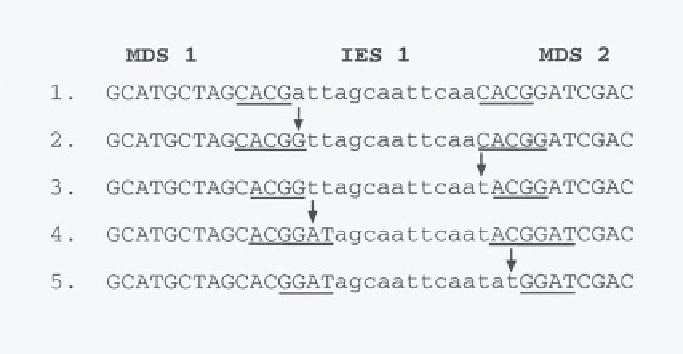Information Technology Reference
In-Depth Information
shortens the IES by one nucleotide, lengthens MDS 1 by 1 bp, and
lengthens the repeat from CACG to CACGG.
2. A second mutation changes the first base in MDS 2 from C to t. This
lengthens the IES by one base, shortens MDS 2 by one base, and
shortens the repeat from CACGG to ACGG.
3. The third mutation changes the first base in the IES from t to A, which
shortens the IES by two bases, lengthens MDS 1 by two bases, and
changes the repeat from ACGG to ACGGAT.
4. A fourth mutation changes the second base in MDS 2 from C to t. This
lengthens the right end of the IES by two bases and shortens MDS 2
by two bases. The repeat, which was originally CACG before the first
mutation, is now very different (i.e., GGAT).
The overall effect of the four mutations, in addition to changing the sequence
of the repeat, is migration of the IES to the right by three bases, adding GAT
to the end of MDS 1 and subtracting CAC from the beginning of MDS 2. This
migration has no effect on the coding properties of the MDSs. Excision of the
IES and one copy of the repeat and ligation of the two MDSs at any step in Figure
9.15 yields a product with exactly the same sequence in the composite MDS.
Thus, IES migration does not change the coding sequence of the gene, but it pro-
gressively changes the sequence and position of an IES, changes the sequence
of the repeat pairs that flank it, and changes the sizes of the flanking MDSs.
IES migration may account for differences in IES positions in a particular
micronuclear gene from one stichotrich species to another. The micronuclear
β
TP gene in
Sterkiella histriomuscorum
contains six IESs, as noted earlier in
Figure 9.15
Internal eliminated segment (IES) migration by mutation of bases (see
text for explanation).

